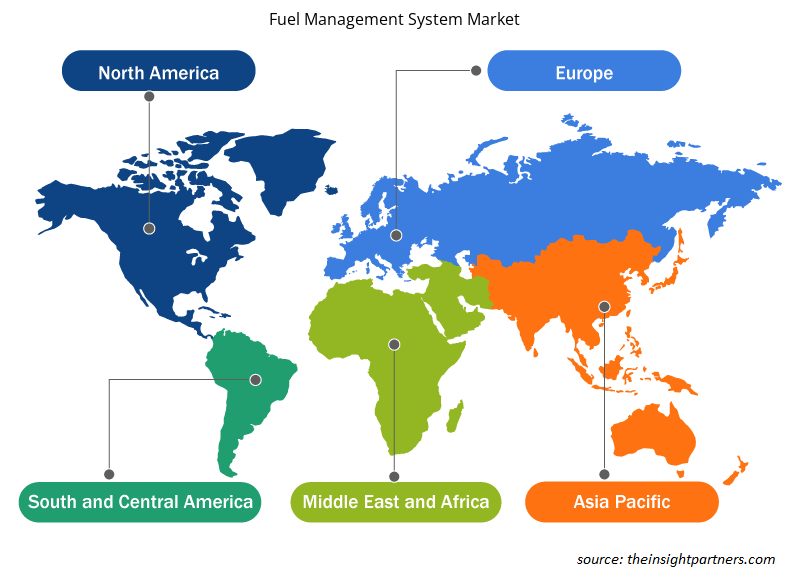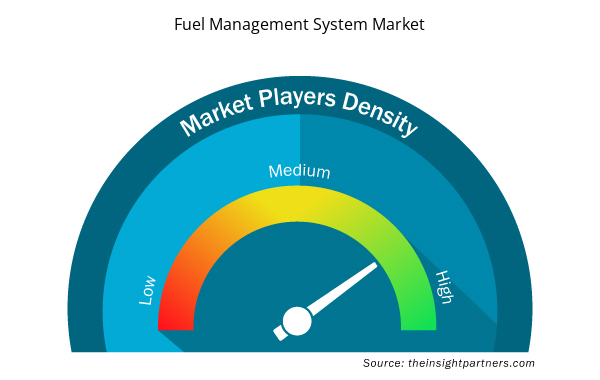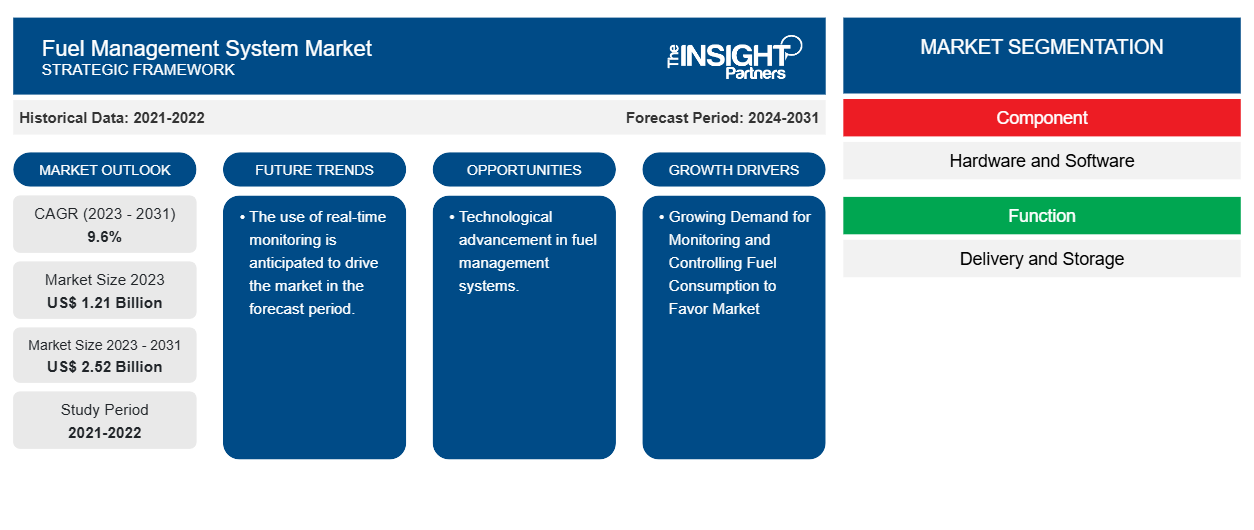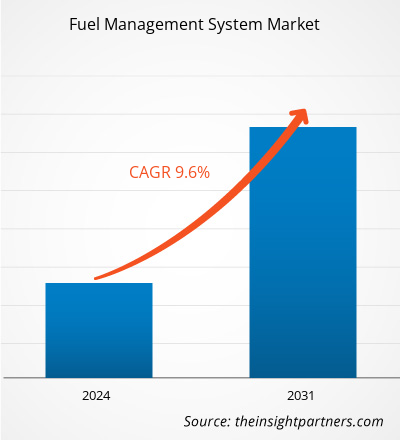من المتوقع أن يصل حجم سوق نظام إدارة الوقود إلى 2.52 مليار دولار أمريكي بحلول عام 2031 من 1.21 مليار دولار أمريكي في عام 2023. ومن المتوقع أن يسجل السوق معدل نمو سنوي مركب بنسبة 9.8٪ خلال الفترة 2023-2031. ومن المرجح أن يظل الطلب المتزايد على مراقبة ومراقبة استهلاك الوقود وزيادة حالات سرقة الوقود من الاتجاهات الرئيسية في السوق.CAGR of 9.8% during 2023–2031. Increasing demand for monitoring and controlling fuel consumption and increasing cases of fuel theft are likely to remain key trends in the market.
تحليل سوق نظام إدارة الوقود
من المتوقع أن ينمو الطلب على سوق أنظمة إدارة الوقود مع الحاجة المتزايدة إلى إدارة أفضل للوقود لتحسين الإنتاجية والكفاءة في العديد من الصناعات. علاوة على ذلك، أدى النمو السريع لمنصات التجارة الإلكترونية لتقديم تجربة أفضل للعملاء إلى دفع صناعات التوريد والخدمات اللوجستية إلى تعزيز صناعات إنترنت الأشياء.
نظرة عامة على سوق نظام إدارة الوقود
نظام إدارة الوقود هو نوع من تكنولوجيا البرمجيات والأجهزة المستخدمة لمراقبة استهلاك الوقود والتحكم فيه وتحسينه في تطبيقات مختلفة، مثل صناعات النقل والبناء والطاقة. في المركبات، يمكن أن تساعد أنظمة إدارة الوقود في ضمان استخدام الوقود بكفاءة من خلال مراقبة استهلاك الوقود وأداء المحرك وعوامل أخرى. يمكن أن يساعد هذا في تقليل تكاليف الوقود وزيادة الكفاءة التشغيلية وخفض الانبعاثات.
قم بتخصيص هذا التقرير ليناسب متطلباتك
ستحصل على تخصيص لأي تقرير - مجانًا - بما في ذلك أجزاء من هذا التقرير، أو تحليل على مستوى الدولة، وحزمة بيانات Excel، بالإضافة إلى الاستفادة من العروض والخصومات الرائعة للشركات الناشئة والجامعات
- احصل على أهم اتجاهات السوق الرئيسية لهذا التقرير.ستتضمن هذه العينة المجانية تحليلاً للبيانات، بدءًا من اتجاهات السوق وحتى التقديرات والتوقعات.
محركات وفرص سوق نظام إدارة الوقود
تزايد الطلب على مراقبة ومراقبة استهلاك الوقود لصالح السوق
إن الطلب المتزايد على مراقبة استهلاك الوقود والتحكم فيه هو المحرك لسوق أنظمة إدارة الوقود، حيث توجد العديد من الفوائد لمراقبة استهلاك الوقود. فوائد مثل توفير التكاليف، وتحديد عدم الكفاءة، والحد من الانبعاثات، وما إلى ذلك. بالإضافة إلى ذلك، فإن الطلب على مراقبة استهلاك الوقود في الوقت الفعلي يتزايد أيضًا. فهو يمكّن الشركات من تحديد ومعالجة هدر الوقود فور حدوثه وليس بعد وقوعه. يمكن أن يساعد هذا الشركات على تقليل استهلاك الوقود والتكاليف في الوقت الفعلي، مما قد يكون له تأثير كبير على صافي أرباحها. بالنظر إلى الفوائد العديدة لمراقبة استهلاك الوقود والتحكم فيه، فإن نظام إدارة الوقود مطلوب.
التقدم التكنولوجي في أنظمة إدارة الوقود.
يحمل التقدم التكنولوجي في أنظمة إدارة الوقود العديد من الفرص. التطورات التكنولوجية مثل تكامل إنترنت الأشياء، والتحليلات التنبؤية، وخوارزميات التعلم الآلي، والبلوك تشين للشفافية، والمركبات الموفرة للطاقة ، وما إلى ذلك. يمكن أن تساعد هذه التطورات العديد من الصناعات، بما في ذلك الخدمات اللوجستية والنقل، والتصنيع وسلسلة التوريد، والزراعة، والبناء، وإدارة الأسطول والخدمات، وما إلى ذلك. وبالتالي، فإن التقدم التكنولوجي في مختلف الصناعات يزيد من الطلب على أنظمة إدارة الوقود.IoT integration, predictive analytics, machine learning algorithms, blockchain for transparency, energy-efficient
تقرير تحليل تجزئة سوق نظام إدارة الوقود
إن القطاعات الرئيسية التي ساهمت في اشتقاق تحليل سوق نظام إدارة الوقود هي المكون والوظيفة والمستخدم النهائي.
- بناءً على المكون، ينقسم سوق نظام إدارة الوقود إلى أجهزة وبرامج. ومن المتوقع أن يحظى قطاع البرامج بحصة سوقية كبيرة خلال فترة التوقعات.
- بناءً على الوظيفة، ينقسم سوق نظام إدارة الوقود إلى قسمي التوصيل والتخزين. ومن المتوقع أن يحظى قطاع التوصيل بحصة سوقية كبيرة خلال الفترة المتوقعة.
- بحسب المستخدم النهائي، يتم تقسيم السوق إلى التعدين والبناء والموانئ والنقل والخدمات اللوجستية والنفط والغاز وغيرها. ومن المتوقع أن يحظى قطاع التعدين بحصة سوقية كبيرة خلال الفترة المتوقعة.
تحليل حصة سوق نظام إدارة الوقود حسب المنطقة الجغرافية
ينقسم النطاق الجغرافي لتقرير سوق نظام إدارة الوقود بشكل أساسي إلى خمس مناطق: أمريكا الشمالية، ومنطقة آسيا والمحيط الهادئ، وأوروبا، والشرق الأوسط وأفريقيا، وأمريكا الجنوبية والوسطى.
سيطرت أمريكا الشمالية على سوق أنظمة إدارة الوقود. وقد أدت اتجاهات تبني التكنولوجيا العالية في مختلف الصناعات في منطقة أمريكا الشمالية إلى تغذية نمو سوق أنظمة إدارة الوقود. ومن المتوقع أن تؤدي عوامل مثل زيادة اعتماد الأدوات الرقمية والإنفاق التكنولوجي العالي من قبل الوكالات الحكومية إلى دفع نمو سوق أنظمة إدارة الوقود في أمريكا الشمالية. علاوة على ذلك، فإن التركيز القوي على البحث والتطوير في الاقتصادات المتقدمة في الولايات المتحدة وكندا يجبر اللاعبين في أمريكا الشمالية على جلب حلول متقدمة تقنيًا إلى السوق. بالإضافة إلى ذلك، يوجد في الولايات المتحدة العديد من اللاعبين في سوق أنظمة إدارة الوقود الذين يركزون بشكل متزايد على تطوير حلول مبتكرة. كل هذه العوامل تساهم في نمو سوق أنظمة إدارة الوقود في المنطقة.fuelled the growth of the fuel management system market. Factors such as increased adoption of digital tools and high technological spending by government agencies are expected to drive the North American fuel management system market growth. Moreover, a strong emphasis on research and development in the developed economies of the US and Canada is forcing the North American players to bring technologically advanced solutions into the market. In addition, the US has many fuel management system market players who have been increasingly focusing on developing innovative solutions. All these factors contribute to the region's growth of the fuel management system market.
رؤى إقليمية حول سوق أنظمة إدارة الوقود
لقد قام المحللون في Insight Partners بشرح الاتجاهات والعوامل الإقليمية المؤثرة على سوق نظام إدارة الوقود طوال فترة التوقعات بشكل شامل. يناقش هذا القسم أيضًا قطاعات سوق نظام إدارة الوقود والجغرافيا في جميع أنحاء أمريكا الشمالية وأوروبا ومنطقة آسيا والمحيط الهادئ والشرق الأوسط وأفريقيا وأمريكا الجنوبية والوسطى.

- احصل على البيانات الإقليمية المحددة لسوق نظام إدارة الوقود
نطاق تقرير سوق نظام إدارة الوقود
| سمة التقرير | تفاصيل |
|---|---|
| حجم السوق في عام 2023 | 1.21 مليار دولار أمريكي |
| حجم السوق بحلول عام 2031 | 2.52 مليار دولار أمريكي |
| معدل النمو السنوي المركب العالمي (2023 - 2031) | 9.6% |
| البيانات التاريخية | 2021-2022 |
| فترة التنبؤ | 2024-2031 |
| القطاعات المغطاة | حسب المكون
|
| المناطق والدول المغطاة | أمريكا الشمالية
|
| قادة السوق وملفات تعريف الشركات الرئيسية |
|
كثافة اللاعبين في سوق أنظمة إدارة الوقود: فهم تأثيرها على ديناميكيات الأعمال
يشهد سوق أنظمة إدارة الوقود نموًا سريعًا، مدفوعًا بالطلب المتزايد من المستخدم النهائي بسبب عوامل مثل تفضيلات المستهلكين المتطورة والتقدم التكنولوجي والوعي المتزايد بفوائد المنتج. ومع ارتفاع الطلب، تعمل الشركات على توسيع عروضها والابتكار لتلبية احتياجات المستهلكين والاستفادة من الاتجاهات الناشئة، مما يؤدي إلى زيادة نمو السوق.
تشير كثافة اللاعبين في السوق إلى توزيع الشركات أو المؤسسات العاملة في سوق أو صناعة معينة. وهي تشير إلى عدد المنافسين (اللاعبين في السوق) الموجودين في مساحة سوق معينة نسبة إلى حجمها أو قيمتها السوقية الإجمالية.
الشركات الرئيسية العاملة في سوق نظام إدارة الوقود هي:
- حلول أسطول شيڤين
- فرانكلين الكتريك
- شركة جيلباركو
- شركة مولتيفورس سيستمز.
- الملاحة 8
- شركة بيوسي
إخلاء المسؤولية : الشركات المذكورة أعلاه ليست مرتبة بأي ترتيب معين.

- احصل على نظرة عامة على أهم اللاعبين الرئيسيين في سوق نظام إدارة الوقود
أخبار سوق أنظمة إدارة الوقود والتطورات الأخيرة
يتم تقييم سوق نظام إدارة الوقود من خلال جمع البيانات النوعية والكمية بعد البحث الأولي والثانوي، والتي تتضمن منشورات الشركات المهمة وبيانات الجمعيات وقواعد البيانات. فيما يلي بعض التطورات في سوق نظام إدارة الوقود:
- أقامت شركة Kongsberg Digital شراكة مع شركة Royston لتقديم نظام إلكتروني لإدارة الوقود. ستمكن هذه الشراكة أصحاب السفن من تحسين استهلاك الوقود وتعزيز الشفافية وتعزيز إزالة الكربون من عمليات السفن من خلال الجمع بين Vessel Insight من شركة Kongsberg Digital ونظام Enginei الإلكتروني لإدارة الوقود من شركة Royston. (المصدر: Royston، موقع شركة Press Company، فبراير 2024)
- أصبحت شركة إيرباص شريكًا استراتيجيًا لشركة DG Fuels, LLC ("DGF")، وهي شركة رائدة ناشئة في مجال وقود الطيران المستدام. يعتمد نظام إنتاج الوقود الخاص بشركة DGF بالكامل على منتجات النفايات السليلوزية، مثل نفايات الخشب من صناعة قطع الأشجار، ومصادر الطاقة المتجددة، مثل طاقة الرياح والطاقة الشمسية. (المصدر: موقع شركة إيرباص على الإنترنت، سبتمبر 2023)
تقرير سوق نظام إدارة الوقود والتغطية والنتائج المتوقعة
يقدم تقرير "حجم سوق نظام إدارة الوقود والتوقعات (2021-2031)" تحليلاً مفصلاً للسوق يغطي المجالات التالية:
- حجم سوق نظام إدارة الوقود وتوقعاته على المستويات العالمية والإقليمية والوطنية لجميع قطاعات السوق الرئيسية المشمولة بالنطاق.
- اتجاهات سوق نظام إدارة الوقود بالإضافة إلى ديناميكيات السوق مثل المحركات والقيود والفرص الرئيسية.
- تحليل مفصل لقوى PEST/Porter الخمس وSWOT
- تحليل سوق نظام إدارة الوقود يغطي اتجاهات السوق الرئيسية والإطار العالمي والإقليمي واللاعبين الرئيسيين واللوائح والتطورات الأخيرة في السوق.
- تحليل المشهد الصناعي والمنافسة الذي يغطي تركيز السوق، وتحليل خريطة الحرارة، واللاعبين البارزين، والتطورات الأخيرة في سوق نظام إدارة الوقود.
- ملفات تعريفية مفصلة للشركة.
- التحليل التاريخي (سنتان)، السنة الأساسية، التوقعات (7 سنوات) مع معدل النمو السنوي المركب
- تحليل PEST و SWOT
- حجم السوق والقيمة / الحجم - عالميًا وإقليميًا وقطريًا
- الصناعة والمنافسة
- مجموعة بيانات Excel


- Wire Harness Market
- Sodium Bicarbonate Market
- Dealer Management System Market
- Redistribution Layer Material Market
- Nurse Call Systems Market
- Visualization and 3D Rendering Software Market
- Artificial Intelligence in Defense Market
- Aircraft MRO Market
- Hair Extensions Market
- Wind Turbine Composites Market

Report Coverage
Revenue forecast, Company Analysis, Industry landscape, Growth factors, and Trends

Segment Covered
This text is related
to segments covered.

Regional Scope
North America, Europe, Asia Pacific, Middle East & Africa, South & Central America

Country Scope
This text is related
to country scope.
الأسئلة الشائعة
The expected CAGR of the fuel management system market is 9.6%.
The global fuel management system market is expected to reach US$ 2.52 billion by 2031.
The use of real-time monitoring is anticipated to drive the market in the forecast period.
The key players holding majority shares in the global fuel management system market are Chevin Fleet Solutions, Franklin Electric, Gilbarco Inc., Multiforce Systems Corporation., Navig8, Piusi S.p.A., OPW Fuel Management Systems Corporate, Orpak Systems Ltd., Banlaw, Syntech Systems, Inc., etc.
Increasing demand for monitoring and controlling fuel consumption and increasing cases of fuel theft are some of the factors driving the fuel management system market.
North America is anticipated to dominate the fuel management system market in 2023.
Trends and growth analysis reports related to Technology, Media and Telecommunications : READ MORE..
The Insight Partners performs research in 4 major stages: Data Collection & Secondary Research, Primary Research, Data Analysis and Data Triangulation & Final Review.
- Data Collection and Secondary Research:
As a market research and consulting firm operating from a decade, we have published and advised several client across the globe. First step for any study will start with an assessment of currently available data and insights from existing reports. Further, historical and current market information is collected from Investor Presentations, Annual Reports, SEC Filings, etc., and other information related to company’s performance and market positioning are gathered from Paid Databases (Factiva, Hoovers, and Reuters) and various other publications available in public domain.
Several associations trade associates, technical forums, institutes, societies and organization are accessed to gain technical as well as market related insights through their publications such as research papers, blogs and press releases related to the studies are referred to get cues about the market. Further, white papers, journals, magazines, and other news articles published in last 3 years are scrutinized and analyzed to understand the current market trends.
- Primary Research:
The primarily interview analysis comprise of data obtained from industry participants interview and answers to survey questions gathered by in-house primary team.
For primary research, interviews are conducted with industry experts/CEOs/Marketing Managers/VPs/Subject Matter Experts from both demand and supply side to get a 360-degree view of the market. The primary team conducts several interviews based on the complexity of the markets to understand the various market trends and dynamics which makes research more credible and precise.
A typical research interview fulfils the following functions:
- Provides first-hand information on the market size, market trends, growth trends, competitive landscape, and outlook
- Validates and strengthens in-house secondary research findings
- Develops the analysis team’s expertise and market understanding
Primary research involves email interactions and telephone interviews for each market, category, segment, and sub-segment across geographies. The participants who typically take part in such a process include, but are not limited to:
- Industry participants: VPs, business development managers, market intelligence managers and national sales managers
- Outside experts: Valuation experts, research analysts and key opinion leaders specializing in the electronics and semiconductor industry.
Below is the breakup of our primary respondents by company, designation, and region:

Once we receive the confirmation from primary research sources or primary respondents, we finalize the base year market estimation and forecast the data as per the macroeconomic and microeconomic factors assessed during data collection.
- Data Analysis:
Once data is validated through both secondary as well as primary respondents, we finalize the market estimations by hypothesis formulation and factor analysis at regional and country level.
- Macro-Economic Factor Analysis:
We analyse macroeconomic indicators such the gross domestic product (GDP), increase in the demand for goods and services across industries, technological advancement, regional economic growth, governmental policies, the influence of COVID-19, PEST analysis, and other aspects. This analysis aids in setting benchmarks for various nations/regions and approximating market splits. Additionally, the general trend of the aforementioned components aid in determining the market's development possibilities.
- Country Level Data:
Various factors that are especially aligned to the country are taken into account to determine the market size for a certain area and country, including the presence of vendors, such as headquarters and offices, the country's GDP, demand patterns, and industry growth. To comprehend the market dynamics for the nation, a number of growth variables, inhibitors, application areas, and current market trends are researched. The aforementioned elements aid in determining the country's overall market's growth potential.
- Company Profile:
The “Table of Contents” is formulated by listing and analyzing more than 25 - 30 companies operating in the market ecosystem across geographies. However, we profile only 10 companies as a standard practice in our syndicate reports. These 10 companies comprise leading, emerging, and regional players. Nonetheless, our analysis is not restricted to the 10 listed companies, we also analyze other companies present in the market to develop a holistic view and understand the prevailing trends. The “Company Profiles” section in the report covers key facts, business description, products & services, financial information, SWOT analysis, and key developments. The financial information presented is extracted from the annual reports and official documents of the publicly listed companies. Upon collecting the information for the sections of respective companies, we verify them via various primary sources and then compile the data in respective company profiles. The company level information helps us in deriving the base number as well as in forecasting the market size.
- Developing Base Number:
Aggregation of sales statistics (2020-2022) and macro-economic factor, and other secondary and primary research insights are utilized to arrive at base number and related market shares for 2022. The data gaps are identified in this step and relevant market data is analyzed, collected from paid primary interviews or databases. On finalizing the base year market size, forecasts are developed on the basis of macro-economic, industry and market growth factors and company level analysis.
- Data Triangulation and Final Review:
The market findings and base year market size calculations are validated from supply as well as demand side. Demand side validations are based on macro-economic factor analysis and benchmarks for respective regions and countries. In case of supply side validations, revenues of major companies are estimated (in case not available) based on industry benchmark, approximate number of employees, product portfolio, and primary interviews revenues are gathered. Further revenue from target product/service segment is assessed to avoid overshooting of market statistics. In case of heavy deviations between supply and demand side values, all thes steps are repeated to achieve synchronization.
We follow an iterative model, wherein we share our research findings with Subject Matter Experts (SME’s) and Key Opinion Leaders (KOLs) until consensus view of the market is not formulated – this model negates any drastic deviation in the opinions of experts. Only validated and universally acceptable research findings are quoted in our reports.
We have important check points that we use to validate our research findings – which we call – data triangulation, where we validate the information, we generate from secondary sources with primary interviews and then we re-validate with our internal data bases and Subject matter experts. This comprehensive model enables us to deliver high quality, reliable data in shortest possible time.


 احصل على عينة مجانية لهذا التقرير
احصل على عينة مجانية لهذا التقرير